- Getting Started
- Administration Guide
-
User Guide
- An Introduction to Wyn Enterprise
- Document Portal for End Users
- Data Governance and Modeling
- Working with Resources
- Working with Reports
-
Working with Dashboards
- Dashboard Designer
- Selecting a Dataset
- Data Attributes
- Dashboard Scenarios
- Dashboard Templates
- Component Templates
- 3D Scene
- Explorer
- Visualization Wizard
- Data Analysis and Interactivity
- Dashboard Appearance
- Preview Dashboard
- Export Dashboard
- Dashboard Lite Viewer
- Using Dashboard Designer
- Animating Dashboard Components
- Document Binder
- Dashboard Insights
- View and Manage Documents
- Understanding Wyn Analytical Expressions
- Section 508 Compliance
- Subscribe to RSS Feed for Wyn Builds Site
- Developer Guide
Symbol Map
In Wyn Enterprise, Symbol Map is a visual representation tool used to display geographical data. It utilizes symbols, such as markers or icons, to represent data points on a map, allowing you to easily visualize and analyze spatial information. Symbol maps are particularly useful for depicting location-based data, such as sales figures by region, customer distribution, or site locations. By leveraging interactive features, users can drill down into specific regions or data points for deeper insights. Symbol maps enhance data comprehension and decision-making by providing a clear and intuitive representation of geographic trends and patterns.
In this help article, you will find information on designing and using a Symbol Map on Wyn dashboards.
Design a Symbol Map
To add a Symbol Map to your dashboard scenario, switch to the Resource Portal or Document Portal and follow the below instructions,
Use the + (create button) and click the Create Dashboard option to access the dashboard designer.
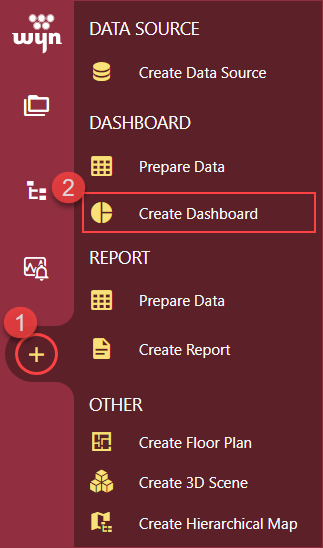
Navigate to the Data Visualization section from the toolbar and drag and drop the Symbol Map scenario onto the dashboard designer area.
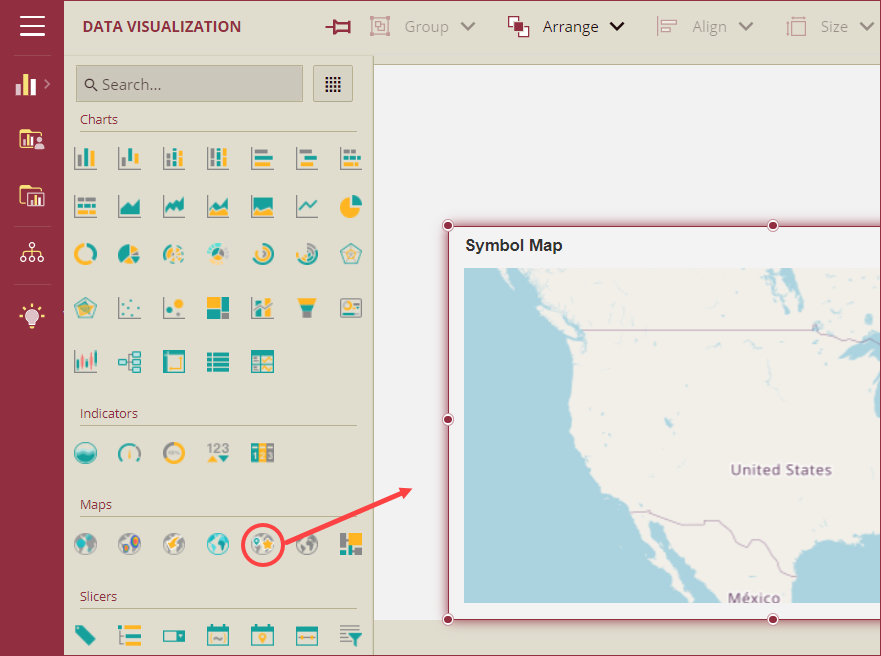
Bind Dataset to Symbol Map
With the map scenario selected, navigate to the Data Binding panel and select a dataset from the Choose Dataset dropdown to bind to the scenario. When the dataset loads successfully, the data binding panel automatically expands and displays the data attributes available for data binding. Drag and drop the appropriate data fields in the Region data container or the Latitude and Longitude data containers. Drag and drop other appropriate fields in the Symbol and Tooltip containers also.
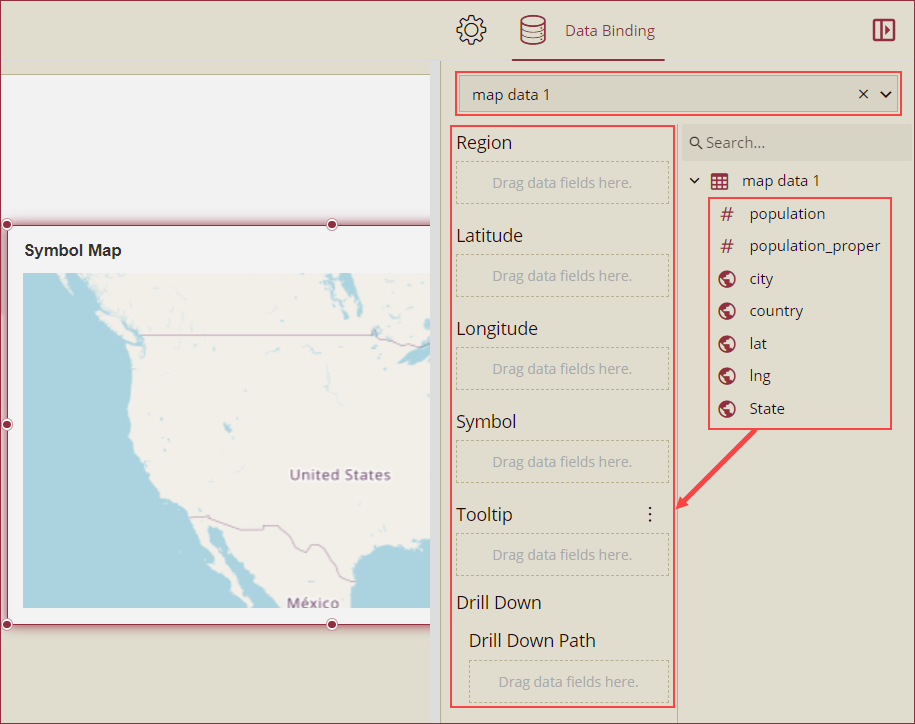
Note: You can bind data fields to the Region or Latitude and Longitude containers. However, if you add fields to all three containers, Latitude and Longitude will take precedence. Aggregation Method for Symbol can take only First and None values.
Format Data Attributes
You can perform various operations to format the data attributes on a symbol map and control the display of data. Use the settings icon in the data field containers to format the data attributes. The following operations are included in the Symbol Map scenario,
Aggregation Method: Use the Aggregation Method option to display a summarized value by aggregating multiple data attribute values. Aggregation Method supports Sum, Average, Min, Max, Count, and Distinct Count methods. See the Aggregation Method help topic for more information.
Filter: The Filter option displays relevant data in your chart scenario. See the Filter Data help article for more information.
Rename: Use the Rename option to change the name of a data attribute to make it comprehensible and meaningful. See the Rename a Data Attribute help article for more information.
Remove: Use the Remove option to remove a data attribute from the chart scenario.
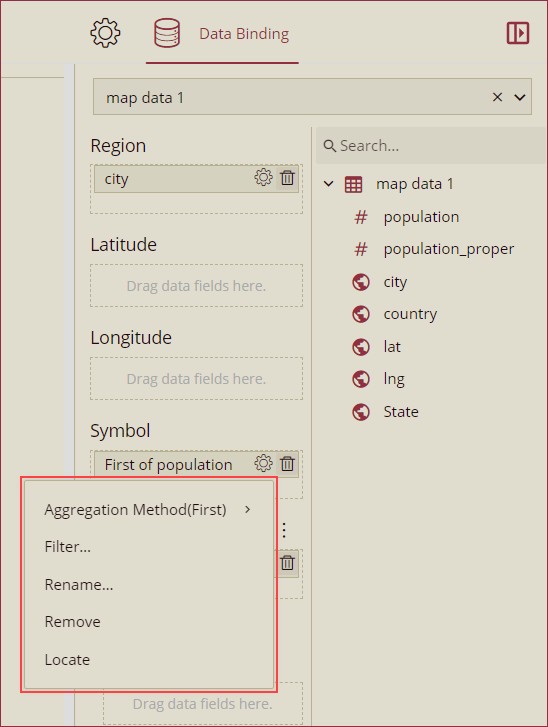
Customize Appearance
You can customize the appearance of the Symbol Map scenario using the Inspector Panel properties on the right side of the dashboard designer window, listed and described in the following tables,
MAP SETTING
Property | Description |
|---|---|
Show Base Map | To enable or disable the reference map use the Show Base Map property. In Wyn Enterprise, Mapbox GIS is used as a base map. By default, the value of this property is set to True. |
Display Area | Select an option from the dropdown,
|
Show Boundary | To enable the display of map boundaries, set the Show Boundary property to True. By default, the value is set to False. When enabled, the following properties are available for modification;
|
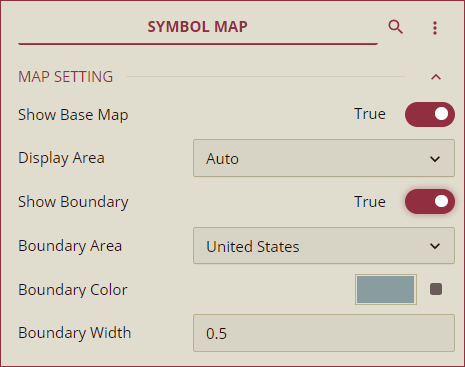
SYMBOL
Property | Description |
|---|---|
Symbol Size | Set the size of the symbols on the map by either using the range slider or input box. The default value is set as 20. |
Symbol Opacity | Set the opacity of the symbols on the map by either using the range slider or input box. The default value is set as 100%. |
Symbol Manage | When no data is bound to the Symbol data container in the Data Binding panel, you can select symbols or choose an image as a symbol from the dropdown. But, when data is bound to the Symbol data container in the Data Binding panel, you can click the Manage button and select a symbol for each value from the Assign Symbol popup. |
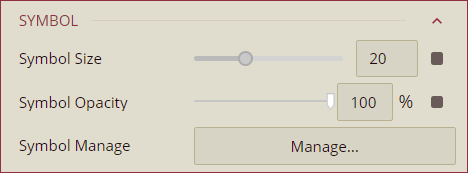
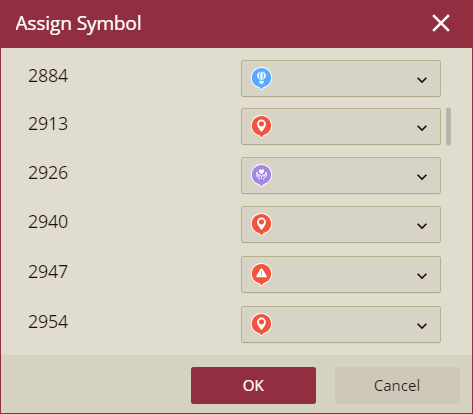
ANIMATION
Property | Description |
|---|---|
Entrance Animation | Select an option from the dropdown to set the animation style of the appearance of the map scenario. After selecting an option (SlideInDown, SlideInLeft, SlideInRight, SlideInUp, SlideInDown, BackInDown, BackInLeft, or BackInRight) from the dropdown, set the delay and duration of the animation using the Delay(s) and Duration(s) properties respectively. |
Animation Carousel | To highlight a region in the area map and display the tooltip, set the Automatic Carousel property to True. By default, this property is set to False. |
INTERACTION
Property | Description |
|---|---|
Scenario Name | Add a name to the map scenario using this property. |
Cross Filter | To disable the filtered data throughout the dashboard, set this property to False. Cross filters provide a simplified and deeper analysis of what you want to observe. By default, the value of the Cross Filter property is set to True. |
Jump To | To create a shortcut to another dashboard scenario, report, or URL use this property. See the Jump To help article for more information. |
Auto Refresh | Set the None, Polling, or Real Time option from the dropdown to refresh the map data. Dropdown options are described below,
|
Visible Menu Items | Select the filtering and sorting options you wish to display on the map scenario from the dropdown. |
Pin Annotation | To pin the annotation to the map scenario, set this property to True. By default, this property is set as False. |
Context Menu Actions | Select multiple Context Menu Options from the dropdown. Context Menu Options include: Keep, Exclude, Drill Down, Jump, and Add Data Monitoring. |
Click Action | Select the None, Keep, Exclude, or Jump option from the dropdown to act on click. |
Single Selection | To allow a single selection of map items, set this property to True. By default, this property is set to False. |
TOOLTIP
Property | Description |
|---|---|
Tooltip Mode | To set the tooltip mode select the None or Data Point option from the dropdown. By default, the Data Point option is selected. |
DATA LABELS
Property | Description |
|---|---|
Show Data Label | To enable or disable the display of data labels on the map use the Show Data Label property. By default, the value of the Show Label Property is set to False. |
Show Location | To disable the region or latitude and longitude display on the map, set the Show Location property to False. By default, the value of the Show Location property is set as True. |
Show Measure | To disable the measure of the map value, set the Show Measure property to False. By default, the value of the Show Measure property is set as True. |
Display Mode | Select an option from the dropdown to display the data labels. Smart option displays the maximum value and the All option displays all data labels in the region. |
Data Label Font Setting | Set the font family, font size, font color, font weight, and font style of the data labels using this property. |
TITLE
Property | Description |
|---|---|
Show Title | To hide the title of the map scenario set this property to False. By default, this property is set to True. |
Title | Add or edit the title of the map scenario using the Title property. |
Alignment | Select the Left, Center, or Right alignment option of the title from the dropdown. |
Title Font Setting | Set the font family, size, color, weight, and style of the title using the Title Font Setting options. |
Padding | To create space around the title of the map scenario use the Padding property. You can set the following: Padding Left, Padding Top, Padding Right, and Padding Bottom. |
DRILL DOWN SETTING
Property | Description |
|---|---|
Position | You can set the display position for the drill-down bar using this property. The dropdown list has the following options: Top Left, Top Center, Top Right, Bottom Left, Bottom Center, and Bottom Right. By default, the Top left is selected. |
Home Name | You can select the initialized text for the drill-down path to be displayed on the preview from here. By default, the value is Home. |
Font | You can set the font for the drill-down path from the font settings. |
Current Level Font Color | You can pick the color for the current level text in the drill-down path by using this property. |
Other Levels Font Color | You can pick the color for the other level text in the drill-down path by using this property. |
Display In Map Area | To display the drill down in the map area, set this property to True. By default, it is set to False.
|
LAYOUT
Property | Description |
|---|---|
X Position | Set the horizontal position of the map scenario on the dashboard using the X Position property. |
Y Position | Set the vertical position of the map scenario on the dashboard using the Y Position property. |
Width | Set the width of the map scenario using the Width property. |
Height | Set the height of the map scenario using the Height property. |
Note: Minimum Height and Width supported is 8X8“.
APPEARANCE
Property | Description |
|---|---|
Style Template | Select a template from the dropdown to apply a style to the map scenario. |
Background Color | Set a background color of the map scenario using this property. |
Padding | To create space around the map scenario, set a padding value. |
Margin | Set the margin value for the map scenario using this property. |
Visibility | To hide the map from the dashboard, set this property to False. By default, the Visibility property is set as True. |
Background Image | Add an embedded, shared, or external image as a background image to the map scenario. |
Border | Set the border type, border color, and thickness using this property. |
Shadow | Create a shadow of the map scenario by setting the Shadow Type, Shadow Color, and thickness. |



